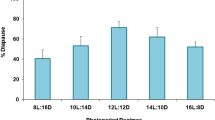Abstract
Newly-moulted adults of three Rhipicephalus appendiculatus stocks, originating from Kenya, Zambia and Zimbabwe, were kept in different photoperiods (12h : 12h, 13h : 11h and 14h : 10h light : dark). The stock originating from Kenya showed almost no behavioural diapause in any of these day lengths, whereas virtually all individuals of the Zimbabwean stock entered a behavioural diapause irrespective of day length. Adults from the Eastern Province of Zambia, a transition zone between the multivoltine phenology in equatorial Africa and the univoltine in southern Africa, exhibited a photoperiod-dependent diapause response. The possible mechanisms of diapause regulation and their origin are discussed.
Similar content being viewed by others
References
Belozerov, V.N. 1982. Diapause and biological rhythms in ticks. In: Physiology of ticks, F.D. Obenchain and R. Galun (eds.). Pergamon Press, Oxford.
Berkvens, D.L., Pegram, R.G. and Brandt, J.R.A. 1995. A study of the diapausing behaviour of Rhipicephalus appendiculatus and Rhipicephalus zambeziensis under quasi-natural conditions in Zambia. Medical and Veterinary Entomology, 9, 307-315.
Berkvens, D.L., Geysen, D.M., Chaka, G., Madder, M. and Brandt, J.R.A. 1998. A survey of the ixodid ticks (Acari: Ixodidae) parasitising cattle in the Eastern Province of Zambia. Medical and Veterinary Entomology, 12, 234-240.
Branagan, D. 1973. The development periods of the Ixodid tick Rhipicephalus appendiculatus Neum. under laboratory conditions. Bulletin of Entomological Research, 63, 155-168.
Colbo, M.H. and MacLeod, J. 1976. Ecological studies of ixodid ticks (Acari: Ixodidae) in Zambia. II. Ticks found on small mammals and birds. Bulletin of Entomological Research, 66, 489-500.
Kaiser, M.N., Sutherst, R.W. and Bourne, A.S. 1982. Relationship between ticks and Zebu cattle in southern Uganda. Tropical Animal Health and Production, 14, 63-74.
Kaiser, M.N., Sutherst, R.W., Bourne, A.S., Gorissen, L. and Floyd, R.B. 1988. Population dynamics of ticks on Ankole cattle in five ecological zones in Burundi and strategies for their control. Preventive Veterinary Medicine, 6, 199-222.
MacLeod, J. and Colbo, M.H. 1976. Ecological studies of ixodid ticks (Acari: Ixodidae) in Zambia. I. Cattle as hosts of the larvae of Amblyomma variegatum (F.) and Rhipicephalus appendiculatus Neum. Bulletin of Entomological Research, 66, 65-74.
MacLeod, J., Colbo, M.H., Madbouly, M.H. and Mwanaumo, B. 1977. Ecological studies of ixodid ticks (Acari: Ixodidae) in Zambia. III. Seasonal activity and attachment sites on cattle, with notes on other hosts. Bulletin of Entomological Research, 67(1), 163-173.
Madder, M and Berkvens, D. 1997. Evaluation of an in vitro method to measure behavioural diapause in the tick Rhipicephalus appendiculatus (Acarina: Ixodidae) in the laboratory. Parasitology, 155, 97-100.
Matson, B.A. and Norval, R.A.I. 1977. The seasonal occurrence of adult ixodid ticks on cattle on a Rhodesian highveld farm. Rhodesian Veterinary Journal, 8, 2-6.
Matthysse, J.G. 1954. Report on tick-borne diseases. Government Printer, Lusaka.
McCulloch, B., Kalaye, W.J., Tungaraza, R., Suda, B'Q.J. and Mbasha, E.M.S. 1968. A study of the life history of the tick Rhipicephalus appendiculatus — the main vector of East Coast Fever — with reference to its behaviour under field conditions and with regard to its control in Sukumaland, Tanzania. Bulletin of Epizootic Diseases in Africa, 16, 477-500.
Minshull, J.I. and Norval, R.A.I. 1982. Factors influencing the spatial distribution of Rhipicephalus appendiculatus in Kyle Recreation Park, Zimbabwe. South African Journal of Wildlife Research, 12(4), 118-123.
Newson, R.M. 1978. The life cycle of Rhipicephalus appendiculatus on the Kenyan coast. In: Tick-borne diseases and their vectors, J.K.H. Wilde (ed.). Lewis Reprints Ltd., Tonbridge.
Newson, R.M. and Punyua, D.K. 1978. The life cycle of Rhipicephalus appendiculatus and associated species in an ecologically marginal situation in central Kenya. In: Tick-borne diseases and their vectors, J.K.H. Wilde (ed.). Lewis Reprints Ltd., Tonbridge.
Norval, R.A.I., Perry, B.D. and Young, A.S. 1992. The epidemiology of Theileriosis in Africa. Academic Press, London.
Pegram, R.G. and Banda, D.S. 1990. Ecology and phenology of cattle ticks in Zambia: development and survival of free-living stages. Experimental & Applied Acarology, 8, 291-301.
Pegram, R.G., Perry, B.D., Musisi, F.L. and Mwanaumo, B. 1986. Ecology and phenology of ticks in Zambia: seasonal dynamics on cattle. Experimental & Applied Acarology, 2, 25-45.
Rechav, Y. 1981. Ecological factors affecting the seasonal activity of the brown ear tick Rhipicephalus appendiculatus. In: Tick Biology and Control, Proceedings of an International Conference held from 27–29 January 1981, under the auspices of the Tick Research Unit, Rhodes University, G.B. Whitehead and J.D. Gibson (eds.). Grahamstown, South Africa.
Rechav, Y. 1982. Dynamics of tick populations (Acari: Ixodidae) in eastern Cape Province of South Africa. Journal of Medical Entomology, 16(6), 679-700.
Rockey, S.J., Hainze, J.H. and Scriber, J.M. 1987. A latitudinal and obligatory diapause response in three subspecies of the eastern tiger swallowtail Papilio glaucus (Lepidoptera: Papilionidae). American Midland Naturalist, 118, 162-168.
Short, N.J. and Norval, R.A.I. 1981. The seasonal activity of Rhipicephalus appendiculatus Neumann 1901 (Acarina: Ixodidae) in the highveld of Zimbabwe Rhodesia. Journal of Parasitology, 67(1), 77-84.
StataCorp 1997. Stata Statistical Software: Release 5.0. Stata Corporation, College Station, Texas.
Tatchell, R.J. and Easton, E. 1986. Tick (Acari: Ixodidae) ecological studies in Tanzania. Bulletin of Entomological Research, 76, 229-246.
Tauber, M.J., Tauber, C.A. and Masaki, S. 1986. Seasonal adaptations of insects. Oxford University Press, New York.
Yeoman, G.H. 1966. Field vector studies of epizootic East Coast Fever. II. Seasonal studies of R. appendiculatus on bovine and non-bovine hosts in East Coast Fever enzootic, epizootic and free areas. Bulletin of Epizootic Diseases in Africa, 14, 113-140.
Author information
Authors and Affiliations
Rights and permissions
About this article
Cite this article
Madder, M., Speybroeck, N., Brandt, J. et al. Diapause induction in adults of three Rhipicephalus appendiculatus stocks. Exp Appl Acarol 23, 961–968 (1999). https://doi.org/10.1023/A:1006363316638
Issue Date:
DOI: https://doi.org/10.1023/A:1006363316638



